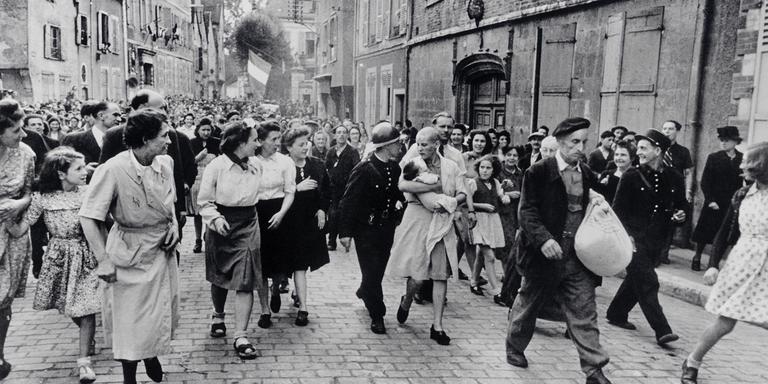


'The Shaved Woman of Chartres' – from history to fiction
Long ReadTaken in 1944 by Robert Capa, this photo has come to symbolize the savage purge that took place during the Liberation. Historians have retraced in detail the career of its protagonist, Simone Touseau, a notorious pro-Nazi. However, in Julie Héraclès's first novel, she is depicted as an opportunistic collaborator driven by a simple spirit of social retribution.
The humiliation of women whose heads were shaved in public remains one of the worst abuses of the Liberation. Historians estimate that 20,000 women were subjected to this hasty "justice." Half of them were accused of "horizontal collaboration" – having slept with Germans. The best-known of these degrading scenes was photographed in Chartres on August 16, 1944, by Robert Capa, for the American magazine Life. In this picture, a woman with a shaven head and a swastika branded across her forehead is clutching a baby as she walks through a jeering crowd. Over time, this photo has become the clearest denunciation of the blind vengeance seen at the end of four years of occupation. We later learned that the woman's name was Simone Touseau, aged 23. She had conceived the child with a Wehrmacht soldier.
Julie Héraclès, a native of Chartres, has attempted to interpret the fate of this character in the first person singular in her first novel, Vous Ne Connaissez Rien De Moi ("You Don't Know Anything About Me," JC Lattès), which comes out on August 23. The book has already been shortlisted for several awards. Placing oneself in the camp of someone reviled is a courageous or even hazardous exercise. Louis Malle, among others, tried his hand at it in 1974, in his film Lacombe, Lucien, making a young militiaman his central character. He provoked an outcry from resistance groups, who accused him of legitimizing collaboration, and he was forced into exile in the United States.
Today, witnesses are rarer and less vociferous. This void gives Julie Héraclès more scope to recreate the story of this woman, renamed Simone Grivise. In a lively style, she paints a portrait of a bold upstart driven by revenge, self-interest, and a drive for social retribution. Buffeted by events, this collaborator never seems to measure the impact of her actions. "A free-spirited woman with an incandescent temperament," reads the book's back cover, with Capa's photo displayed on the banner.
A distorting mirror
To a broad canvas of true facts about Simone Touseau, the novelist has added invented elements that change our perception of this woman. Simone Grivise has an abortion during the Second World War, after being raped and scorned by a young man called Pierre. He abandons her to join the Resistance. She enters into collaboration out of a desire for revenge (in the manner of Louis Malle's Lucien, a fictional character himself). Her mother is an alcoholic. Her best childhood friend is Jewish. Simone Grivise tries to help two children rejected by Chartreuse society because of their yellow stars. She even saves a resistance fighter. These imaginary additions create a distorting mirror that Julie Héraclès has tried to justify: "I took a lot of liberties with historical truth. I lacked the information to explore this woman's personality or the motivations that drove her to collaboration. Fiction allowed me to imagine humiliations she may have suffered."
You have 69.6% of this article left to read. The rest is for subscribers only.
